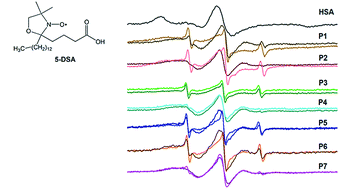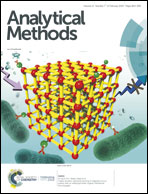Spin probe method of electron paramagnetic resonance spectroscopy – a qualitative test for measuring the evolution of dry eye syndrome under treatment†
Abstract
Tear composition is a source of information on the health state of the eye. Dry eye syndrome represents nowadays a common disorder that can be associated with other eye diseases, in particular keratoconus. As such, we focussed on the correlation of selected protein levels with ophthalmic parameters and, as a novelty, we explored the possible correlation of these data, classically used in examination, with electron paramagnetic resonance (EPR) spectral parameters of spin probes. Three groups of patients with (i) dry eye syndrome, (ii) dry eye syndrome and keratoconus and (iii) healthy eyes were considered. Tears were collected from the subjects to determine the levels of total protein, lactoferrin, lysozyme and human serum albumin, and to record the EPR spectra of spin probes with fatty acid-like structures: 5-doxyl stearic acid (5-DSA) and 4-(N,N′-dimethyl-N-hexadecyl)ammonium-2,2′,6,6′-tetramethylpiperidine-1-oxyl iodide (CAT16). In tear secretion, the EPR spectra of spin probes showed two components, one with slow dynamics and another one revealing a quasi-isotropic, rapid motion. We analysed in depth the changes observed in the EPR spectra of 5-DSA for the reason that the differences in dynamics between the 5-DSA components are more evident. The challenge of this study was to provide an alternative to biochemical analysis in monitoring the evolution of the health state of patients diagnosed with dry eye syndrome or keratoconus using the information provided by EPR spectra of spin probes. The results indicate a decreased contribution of the EPR component with rapid motion following treatment, and a significant correlation with the Schirmer and/or BUT values.



 Please wait while we load your content...
Please wait while we load your content...